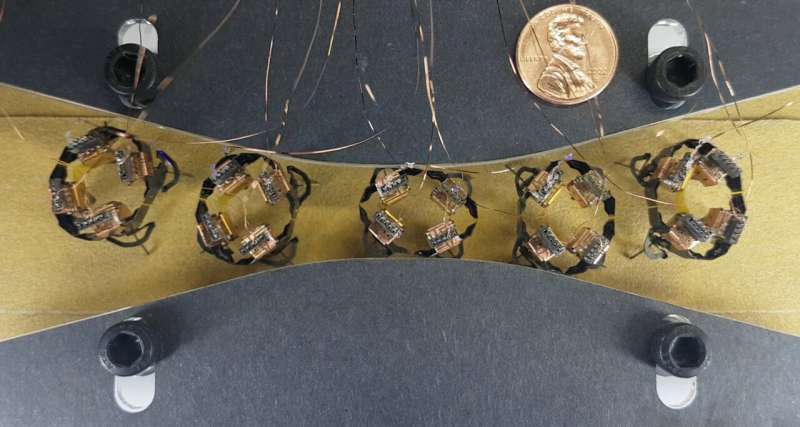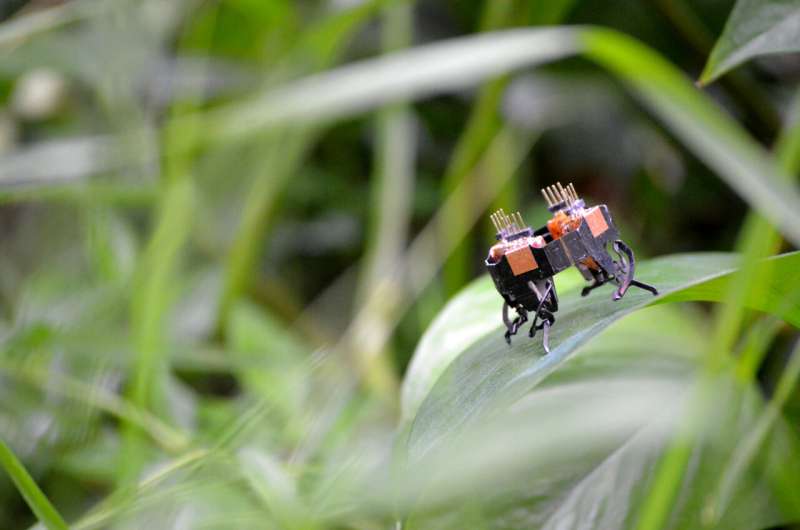This shape-changing robot just got a lot smaller. In a new study, engineers at the University of Colorado Boulder debuted mCLARI, a 2-centimeter-long modular robot that can passively change its shape to squeeze through narrow gaps in multiple directions. It weighs less than a gram but can support over three times its body weight as an additional payload.
The research was led by Kaushik Jayaram, assistant professor in the Paul M. Rady Department of Mechanical Engineering, and doctoral student Heiko Kabutz. Their work recently won the Best Paper Award on Safety, Security, and Rescue Robotics at the 2023 International Conference on Intelligent Robots and Systems in Detroit.
The paper improves on the team’s previous miniature shape-morphing robot, called CLARI, by making it smaller and faster. The robot can maneuver expertly in cluttered environments by switching from running forward to side-to-side, not by turning but changing its shape, giving it the potential to aid first responders after major disasters. The research brings Jayaram’s group one step closer to realizing insect-scale robots that can move seamlessly in natural terrains similar to their animal counterparts—largely by combining a soft robot’s adaptability with a rigid robot’s agility.
Their latest version is scaled down 60% in length and 38% in mass, while maintaining 80% of the actuation power relative to its predecessor. The robot is also more than three times as fast as its predecessor, reaching running speeds of 60 millimeters per second, or three of its body lengths per second. Additionally, similar to CLARI, the robot is capable of locomoting in a variety of shapes and running at multiple frequencies using multiple gaits.
This latest breakthrough in miniaturization is enabled by the origami-based design and laminate fabrication technique Jayaram and his colleagues previously used to make a robot called HAMR-Jr. Using this novel approach, Jayaram and Kabutz are able to scale down (or up) their design without sacrificing mechanical dexterity, bringing such robots closer in size to real-world application needs. That includes inspecting and maintaining valuable assets like jet engines.
Kabutz, the lead author of the new study, has surgeon-like hands that allow him to build and fold the tiny leg modules of the robot. Kabutz grew up fascinated by robots and competed in robotic competitions in high school.

“Initially, I was interested in building bigger robots,” said Kabutz, “but when I came to Jayaram’s lab, he really got me interested in building bioinspired robots at the insect scale.”
“Since these robots can deform, you can still have slightly larger sizes,” Jayaram said. “If you have a slightly more size, you can carry more weight. You can have more sensors. You’ll have a longer lifetime and be more stable. But when you need to, you can squish through and go into those specific gaps, such as inspection access ports in a jet engine.”

Jayaram’s research team studies concepts from biology and applies them to the design of real-world engineered systems. In his lab, you can find robots modeled after the body morphologies of various arthropods, including cockroaches and spiders.
“We are fundamentally interested in understanding why animals are the way they are and move the way they do,” said Jayaram, “and how we can build bioinspired robots that can address social needs, like search and rescue, environmental monitoring or even use them during surgery.”
Co-authors of the new study include Alex Hedrick and Parker McDonnell, doctoral students in mechanical engineering.
More information:
Heiko Kabutz et al, mCLARI: a shape-morphing insect-scale robot capable of omnidirectional terrain-adaptive locomotion in laterally confined spaces, arXiv (2023). DOI: 10.48550/arxiv.2310.04538
Citation:
Spider-inspired, shape-changing robot now even smaller (2023, November 4)
retrieved 5 November 2023
from https://techxplore.com/news/2023-11-spider-inspired-shape-changing-robot-smaller.html
This document is subject to copyright. Apart from any fair dealing for the purpose of private study or research, no
part may be reproduced without the written permission. The content is provided for information purposes only.

